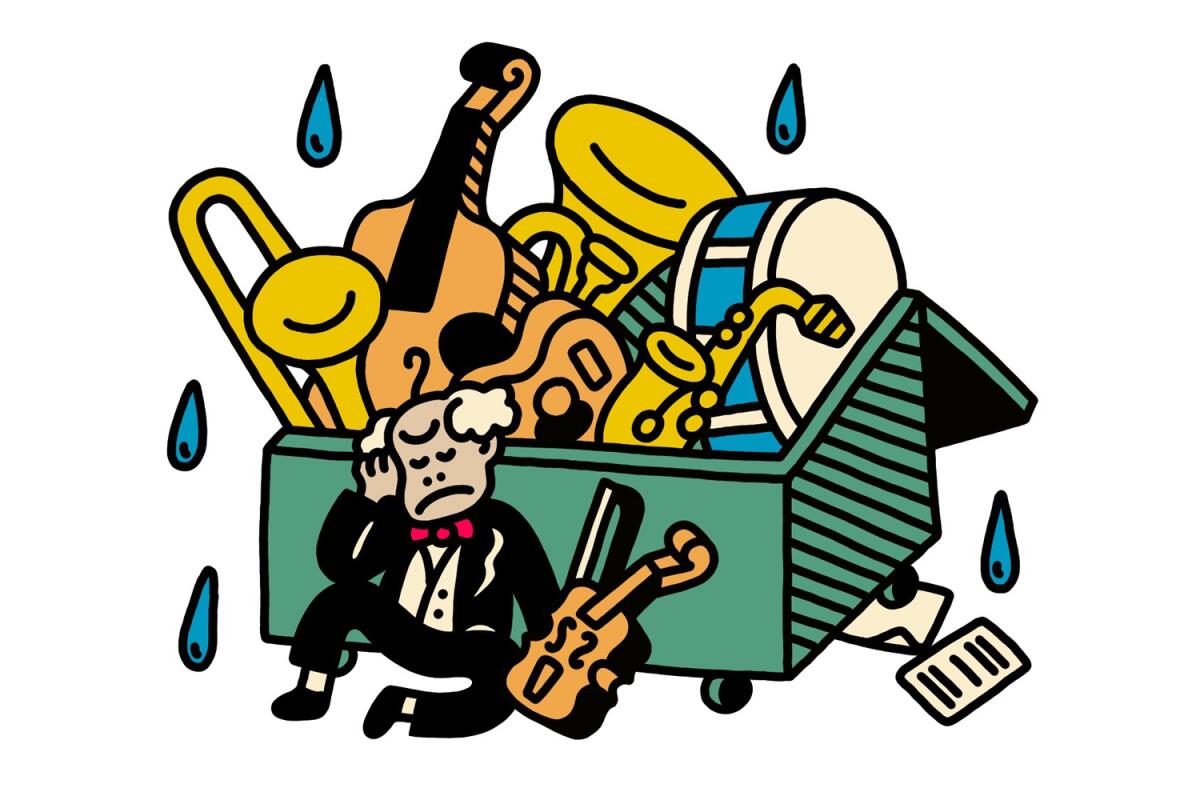Commentary: Music is essential to movies. Too bad the Academy Museum fails to treat it that way

The Los Angeles Philharmonic will devote a weekend in November to three programs of film music. The orchestra is calling the project “Reel Change: The New Era of Film Music.”
That seems natural enough. No one needs to be told about the lure of film music, right? Show me an orchestra that doesn’t play film scores these days. John Williams has triumphantly conducted the august Vienna Philharmonic!
On its website, the L.A. Phil notes that although music was first used in film to drown out the sound of the projector, it quickly “took on a life of its own.” This cutting-edge orchestra got that right. Real reel change, we learn from the Academy Museum of Motion Pictures, is precisely that film music must have a life — and presumably a home — of its own.
So, go ahead, trudge up and down gallery after gallery devoted to every aspect of filmmaking. Cinematography, editing, script writing, directing, acting, set design, sound design, costumes, makeup. They’re all there. All that’s missing is the history of catering on location.
And, of course, film scores.
That is not to say there isn’t music. With film clips showing all through the building, it would be a lot of trouble to edit out all the music, but the academy has said it is at least making an effort to keep the sound down, lest too much music bleed from one space to another. That’s bloody music for you.
Although there is no gallery for film scores, there is a room with a surround-sound setup. From time to time, film composers will be thrown a bone by being commissioned to create a sound installation piece. The first is by Hildur Guonadottir, who wrote the soundtrack for “Joker.” Overstimulated museum-goers can pop in for a quick minute to check it out and chill.
The museum also boasts a 1,000-seat state-of-the-art movie theater with loudspeakers ready to handle whatever contrivance Dolby can throw at them. Even more impressive is the inclusion of a small stage for an orchestra, in case the museum wants to bring in musicians to accompany silent pictures, just like in the movie palaces of old. It is even named David Geffen Theater, after the philanthropist who made his initial fortune in — wouldn’t you know it? — the music business.
The Academy Museum of Motion Pictures has opened as the ultimate celebration of Hollywood history, Oscar lore and today’s movie makers.
Curiouser and curiouser, the academy chose as its museum architect music-besotted Renzo Piano, who has said everything he builds aspires to music. Piano’s contribution to music includes the computer music center, IRCAM, next to the Centre Pompidou in Paris, where Pierre Boulez created his surround-sound masterpiece, “Répons,” which then inspired Piano’s spectacular London tower known as the Shard.
Moreover, Piano’s friendship with the two greatest and most influential Italian composers of his generation, Luciano Berio and Luigi Nono, has had historic consequences. Collaborating with Berio, Piano designed Rome’s great music complex, Parco della Musica. For the staging of Nono’s visionary opera “Prometo,” Piano invented a “musical space” that revolutionized the whole notion of immersive opera (apparently a little too immersive for the museum’s bare-bones “immersive” music gallery).
When I heard that Piano had been hired by the Academy Museum, my first thought was that he would also be asked to fix the Dolby Theatre as part of the renovation of Hollywood & Highland. When the film academy opened it as the Kodak Theatre in 2001, it presented its new home for the Oscars as a faux opera house presenting faux opera. “I wrack my memory to recall a concert in which music was worse served,” I wrote then.
The studios, of course, have a long and famous history of cluelessness when it comes to soundtracks. They’ve tossed countless original scores into the trash to reduce clutter. Could it be that one compelling reason for not devoting galleries to musical scoring is that there isn’t enough music memorabilia left to display?
Enough ludicrous things studio heads — sitting in their offices, feet on their desks, puffing on big stogies — have said and done to composers could fill an amusing book. André Previn loved to recount an early assignment he had as a novice film composer just out of high school in the early 1950s. Look, kid, he was told, this is a picture that takes place in Paris, so make sure you’ve got enough French horns.
Be that as it may, you cannot talk about the history of music over the past 120 years without taking the influence of music on motion pictures into account, and vice versa. It’s not always positive. “Hollywood” has been a pejorative in some serious music circles, standing for cheapening, for selling out, but isn’t that part of the complex and meaningful story as well?
Devoting an entire museum to the émigré composers who came to L.A. in the 1930s to escape Nazi persecution, just as talkies were taking off, is not out of the question. They invented the symphonic score. In the process, they made music so much a part of moviemaking that the “vow of chastity” for the short-lived Dogme 95, the Danish movement to liberate movies from the studios and commercial filmmaking, included the edict that no music could be used unless it was already part of the live scene as it was being shot.
It turned out that Dogme 95 co-founder Lars von Trier couldn’t abide by that for long. Realizing just how powerful music could be, he made indescribably disturbing use of music in the scene that opens his “Antichrist.” An infant is killed falling out a window while his parents are distracted by lustful sex, and in the background is utterly heavenly Handel.
Music is sure to find its way into the museum here and there. It is not possible to keep music out of its exhibitions. Music people will always be sneaking up in every corner of the museum and in its activities. Sophia Loren, the first recipient of the museum’s Visionary Award, has a little secret: Her son is a conductor with an L.A. orchestra of his own (good thing the academy doesn’t pay attention to concerts).
“The Wizard of Oz” and “Citizen Kane” have been selected as iconic films deserving a museum spotlight. It would be hard to think of either one sans music. But they’ll figure something out. Of course, Orson Welles’ and Alfred Hitchcock’s favorite composer, Bernard Herrmann, is worthy of gallery all to himself.
Still, for me, the most disingenuous aspect of the Academy Museum is its contention to chronicle Hollywood‘s troubled history in dealing with issues of diversity. What could be more Eurocentric than to let music in only through the back door, the way musicians had to use the servants’ entrance to the European courts in the 18th century?
Music, however you frame it, is out of the picture, but we should have figured that out all along. The Academy Museum of Motion Pictures is officially called, for short, the Academy Museum, not the Motion Picture Museum. It is not, nor can it pretend to be without film music, a movie museum. It is an Academy museum. That is not the same thing.
More to Read
The biggest entertainment stories
Get our big stories about Hollywood, film, television, music, arts, culture and more right in your inbox as soon as they publish.
You may occasionally receive promotional content from the Los Angeles Times.












